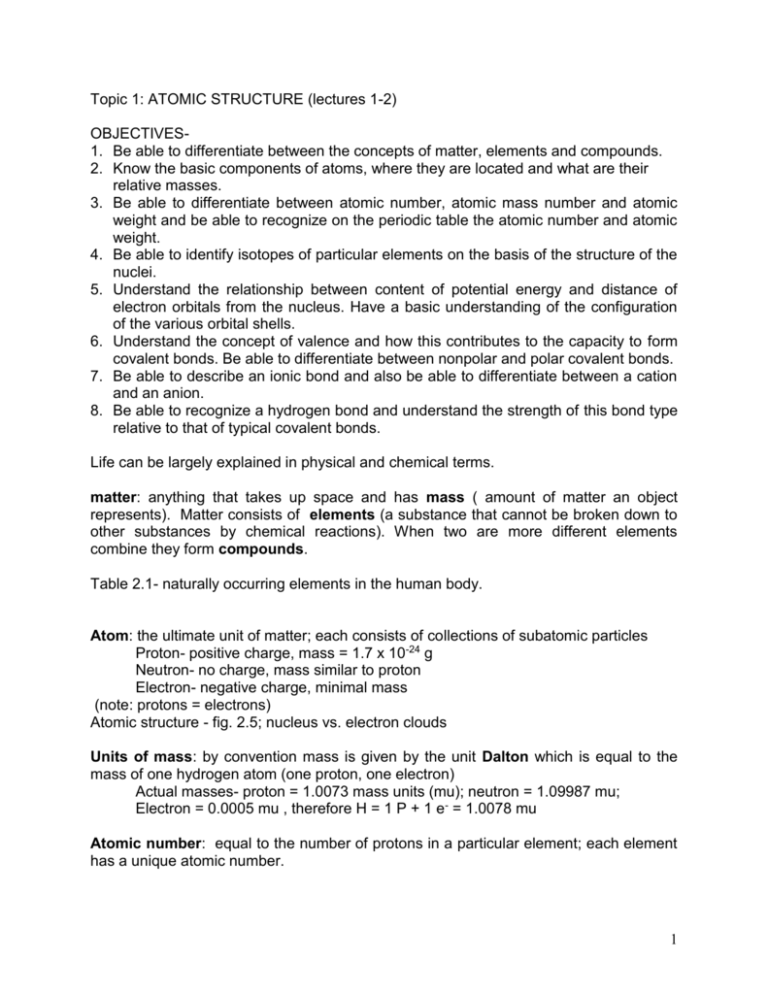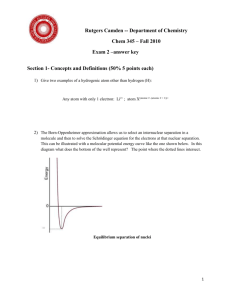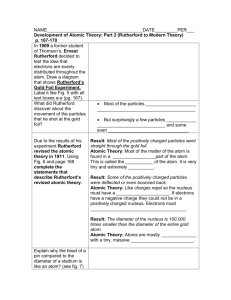Topic 1: ATOMIC STRUCTURE-
advertisement

Topic 1: ATOMIC STRUCTURE (lectures 1-2) OBJECTIVES1. Be able to differentiate between the concepts of matter, elements and compounds. 2. Know the basic components of atoms, where they are located and what are their relative masses. 3. Be able to differentiate between atomic number, atomic mass number and atomic weight and be able to recognize on the periodic table the atomic number and atomic weight. 4. Be able to identify isotopes of particular elements on the basis of the structure of the nuclei. 5. Understand the relationship between content of potential energy and distance of electron orbitals from the nucleus. Have a basic understanding of the configuration of the various orbital shells. 6. Understand the concept of valence and how this contributes to the capacity to form covalent bonds. Be able to differentiate between nonpolar and polar covalent bonds. 7. Be able to describe an ionic bond and also be able to differentiate between a cation and an anion. 8. Be able to recognize a hydrogen bond and understand the strength of this bond type relative to that of typical covalent bonds. Life can be largely explained in physical and chemical terms. matter: anything that takes up space and has mass ( amount of matter an object represents). Matter consists of elements (a substance that cannot be broken down to other substances by chemical reactions). When two are more different elements combine they form compounds. Table 2.1- naturally occurring elements in the human body. Atom: the ultimate unit of matter; each consists of collections of subatomic particles Proton- positive charge, mass = 1.7 x 10-24 g Neutron- no charge, mass similar to proton Electron- negative charge, minimal mass (note: protons = electrons) Atomic structure - fig. 2.5; nucleus vs. electron clouds Units of mass: by convention mass is given by the unit Dalton which is equal to the mass of one hydrogen atom (one proton, one electron) Actual masses- proton = 1.0073 mass units (mu); neutron = 1.09987 mu; Electron = 0.0005 mu , therefore H = 1 P + 1 e- = 1.0078 mu Atomic number: equal to the number of protons in a particular element; each element has a unique atomic number. 1 See periodic table in your general chemistry text. Atomic mass number: equal to sum of the number of protons and neutrons in an element. Atomic weight is the sum of masses. For carbon ( C ) has six protons and six neutrons so its atomic weight is 12 ( 12.009 to be exact). Number of neutrons = Atomic Mass Number – Atomic Number 12 normally written with atomic number as subscript and mass number as 6C superscript Isotope: some elements exist in multiple forms which differ in terms of number of neutrons present. For instance, think of carbon 12 C6 13 C6 14 C6 naturally abundant > 98% heavy carbon <2%; 1 extra neutron radioactive carbon; spontaneously decomposes; not very abundant; 2 extra neutrons Atomic structure and reactive chemistry of elements is related to structure of electron clouds surrounding nuclei. Electrons orbit around nuclei due to the attraction of the protons. Electrons vary in terms of their energy content (energy- ability [capacity] to do work). Fig. 2.9Potential energy- energy stored in matter due to its position or location. Electrons orbit at different distances from the nucleus; the farther away from the nucleus, the higher the potential energy. These form discrete energy levels or shells which actually consist of orbitals (statistical 3-D space through which an electron will travel). Each orbital can have at a maximum only 2 electrons. Fig. 2.11The first electron shell consists of one orbital (1s). The second and subsequent shells consist of four orbitals ( s [sphere] orbital and three p [Pi] orbitals). The three p orbitals are arranged at right angles to each other (see Fig. 2.11). Note the terminology for the orbitals in each shell- 2s and 2p, 3s and 3p and so on. Notation for electronic configuration- Number of electrons in the subshell orbitals 2p5 Shell Subshell orbital type 2 Element Atomic Number Electronic configuration H Li C O Al K 1 3 6 8 13 19 1s 1s22s1 1s22s22p2 1s22s22p4 2 1s 2s22p63s23p1 1s22s22p63s23p64s1 shells 1-3 are fully occupied; lone electron in outer shell (# 4) Note: there are also d- and f- type orbitals. There are other orbitals(a) transition metals , scandium [Sc] (21) mercury [Hg] (80) there are d orbitals assembled into shells with a maximum of 10 electrons (b) lanthanides( rare earths) and actinides have f-type orbitals assembled into shells with a maximum of 14 electrons Fig. 2.10- chemical properties of atoms are dependent on the number of electrons in their outermost shell (often referred to as the valence shell). The electrons in this shell are often called valence electrons. It is these electrons that interact with other atoms to form chemical bonds. If all the orbitals in the outer shell are full (that is there are no unpaired electrons), the atom is unreactive; it cannot combine with other atoms (see right hand column on Fig. 2.10). Chemical bonds (1) Covalent bond- two atoms share a pair of electrons (see Fig. 2.12); these are typically rather strong bonds. valence- the bonding capacity of an atom; the number of covalent bonds that can be formed to give an atom a full complement of electrons in the outer shell. Positive valence means the atom can donate electrons; negative valence means that the atom can receive electrons. Examples by looking at Fig. 2.10 - H (+1), O (-2), F (-1), C (+4), He (0). (LOOK ACROSS EACH ROW OF THE PERIODIC TABLE!). Electronegativity- the attraction of an atom for electrons; an intrinsic property of an atom; atoms differ in their electronegativity with oxygen being one of the most electronegative. There is a scale of electronegativity- F(4), O(3.5), N(3), C(2.5), P(2.1), H(2.1) 3 Nonpolar covalent bond- electrons are shared equally; see Fig. 2.12 for examples (H2, O2, CH4); C and H are not substantially different in terms of their electronegativity. Polar covalent bond- one atom is more electronegative than the other so that electrons spend a greater amount of time around the more electronegative atom. This creates polarity in that the electronegative atom attains a slight negative charge and the less electronegative atom a slight positive charge. A good example is H 2O (Fig. 2.12)O(3.5) vs. H(2.1) (polar = lack of symmetry of charge) (2) Ionic bonds- when two atoms differ substantially in terms of their electronegativity, one atom may literally strip the electron from the other atom producing charged atoms called ions; the positively charged ion is called a cation and negatively charged ion called an anion. An ionic bond is formed by the interaction of a cation and an anion (see Fig. 2.14). (3) Weak bonds- a variety of weak bonding and interactions are important in living systems. These are weak in that they can be easily disrupted which actually is important from a functional perspective. These include hydrogen bonding, van der Waals forces and hydrophobic interactions some of which will be discussed later. Fig. 2.16- hydrogen bond; interaction of a weakly positive hydrogen atom with a weakly negative atom such as oxygen or nitrogen; very important in stabilizing the structure of macro- (large) molecules such as proteins and nucleic acids. Weak bonds can easily be disrupted by changes in temperature (1) hydrogen bonds- increased temperature destabilizes; and vice versa (2) hydrophobic interactions- increased temperature stabilizes; and vice versa Chemical Reactions- involve the breaking and the formation of chemical bonds (typically covalent); living processes involve regulated chemical reactions. To be discussed in greater detail when be reach the lectures on Thermodynamics 4







